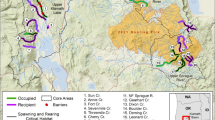Abstract
Ecological risks of Pacific salmon (spring, summer, and fall run Chinook, coho, and sockeye salmon) and steelhead trout hatchery programs operated between 2013 and 2023 in the Upper Columbia Watershed will be assessed using Delphi and modeling approaches. Committees composed of resource managers and public utility districts identified non-target taxa of concern (i.e., taxa that are not the target of supplementation), and acceptable hatchery impacts (i.e., change in population status) to those taxa. Biologists assembled information about hatchery programs, non-target taxa, and ecological interactions and this information will be provided to expert panelists in the Delphi process to facilitate assessment of risks and also used to populate the Predation, Competition, and Disease (PCD) Risk 1 model. Delphi panelists will independently estimate the proportion of a non-target taxa population that will be affected by each individual hatchery program. Estimates from each of the two approaches will be independently averaged, a measure of dispersion calculated (e.g., standard deviation), and subsequently compared to the acceptable hatchery impact levels that were determined previously by committees of resource managers and public utility districts. Measures of dispersion will be used to estimate the scientific uncertainty associated with risk estimates. Delphi and model results will be compared to evaluate the qualities of the two approaches. Furthermore, estimates of impacts from each hatchery program will be combined together to generate an estimate of cumulative impact to each non-target taxon.


Similar content being viewed by others
References
Busack CA, Currens KP, Pearsons TN, Mobrand LM (2005) Tools for evaluating ecological and genetic risks in hatchery programs. Final report to Bonneville Power Administration (project 2003-058-00, contract BPA00016399)
Ham KD, Pearsons TN (2001) A practical approach for containing ecological risks associated with fish stocking programs. Fisheries 25(4):15–23
Hatchery Scientific Review Group (HSRG) (2009) Columbia River hatchery reform project final system-wide report. http://www.hatcheryreform.us/hrp/reports/system/welcome_show.action. Accessed July 28, 2010
Letcher BH, Rice JA, Crowder LB, Binkowski FP (1996) Size-dependent effects of continuous and intermittent feeding on starvation time and mass loss in starving yellow perch larvae and juveniles. Transactions of the American Fisheries Society 125:14–26
McCarthy MA, Keith D, Tietjen J, Burgman MA, Maunder M, Master L, Brook BW, Mace G, Possingham HP, Medellin R, Andelman S, Regan H, Regan T, Ruckelshaus M (2004) Comparing predictions of extinction risk using models and subjective judgement. Acta Oecol 26(2004):67–74. doi:10.1016/actao.2004.01.008
Murdoch A, Peven C (2005) Conceptual approach to monitoring and evaluating the Chelan County Public Utility District Hatchery Programs. Final report to the Chelan PUD Habitat Conservation Plan’s Hatchery Committee
Pearsons TN (2008) Misconception, reality, and uncertainty about ecological interactions and risks between hatchery and wild salmonids. Fisheries 33(6):278–290
Pearsons TN (2010) Operating hatcheries within an ecosystem context using the adaptive stocking concept. Fisheries 35(1):23–31
Pearsons TN, Busack CA (2011) PCD Risk 1: a tool for assessing and reducing ecological risks of hatchery operations in freshwater. Environmental Biology of Fishes
Pearsons TN, Hopley CW (1999) A practical approach for assessing ecological risks associated with fish stocking programs. Fisheries 24(9):16–23
Pearsons TN, Langshaw RB (2009) Monitoring and evaluation plan for Grant PUDs salmon and steelhead supplementation programs. Grant PUD, Ephrata
Regan TJ, Master LL, Hammerson GA (2004) Capturing expert knowledge for threatened species assessments: a case study using NatureServe conservation status ranks. Acta Oecol 26(2004):95–107. doi:10.1016/j.actao.2004.03.013
Vedan A (2002) Okanagan environmental knowledge and fisheries management. Report to Okanagan National Fisheries Commission. Okanagan Nation Alliance, Westbank
Acknowledgements
We thank the members of the Wells Hatchery Committee, Rocky Reach Hatchery Committee, and Priest Rapids Coordinating Committees Hatchery Sub-Committee for their work on selection of NTTOC, containment objectives, and regional experts. We also thank the many local experts who helped with providing data and opinions about interactions. These experts included: John Arterburn, Charles Snow, John Crandall, Kirk Truscott, and David Hopkins. Ali Wick and Carmen Andonaegui were instrumental in helping facilitate discussions as well as recording and compiling information. Chad Herring created Fig. 1. Public Utility District Number 1 of Chelan County, Public Utility District Number 1 of Douglas County, and Public Utility District Number 2 of Grant County helped fund this effort.
Author information
Authors and Affiliations
Corresponding author
Rights and permissions
About this article
Cite this article
Pearsons, T.N., Murdoch, A.R., Mackey, G. et al. Ecological risk assessment of multiple hatchery programs in the upper Columbia watershed using Delphi and modeling approaches. Environ Biol Fish 94, 87–100 (2012). https://doi.org/10.1007/s10641-011-9884-1
Received:
Accepted:
Published:
Issue Date:
DOI: https://doi.org/10.1007/s10641-011-9884-1




